Predicting radiation pneumonitis in lung cancer using machine learning and multimodal features: a systematic review and meta-analysis of diagnostic accuracy
- PMID: 39501204
- PMCID: PMC11539622
- DOI: 10.1186/s12885-024-13098-5
Predicting radiation pneumonitis in lung cancer using machine learning and multimodal features: a systematic review and meta-analysis of diagnostic accuracy
Abstract
Objectives: To evaluate the diagnostic accuracy of machine learning models incorporating multimodal features for predicting radiation pneumonitis in lung cancer through a systematic review and meta-analysis.
Methods: Relevant studies were identified through a systematic search of PubMed, Web of Science, Embase, and the Cochrane Library from October 2003 to December 2023. Additional studies were located by reviewing bibliographies and relevant websites. Two independent researchers screened titles, abstracts, and full-text articles according to predefined inclusion and exclusion criteria. Data extraction was performed using standardized forms, and study quality was assessed using the Quality Assessment of Diagnostic Accuracy Studies-2 tool. The primary outcomes, including combined sensitivity, specificity, positive likelihood ratio (PLR), negative likelihood ratio (NLR), diagnostic odds ratio (DOR), and area under the curve (AUC), were calculated using STATA MP-64 software(Stata Corporation LLC, College Station, USA) with a random-effects model. Meta-analysis was conducted to synthesize diagnostic accuracy measures, and analyses of heterogeneity and publication bias were performed.
Results: A total of 1,406 patients with primary lung cancer were included in this systematic review, drawing data from 9 studies. The pooled analysis revealed a sensitivity of 0.74 [0.58-0.85] and a specificity of 0.91 [0.87-0.95] for machine learning models in diagnosing radiation pneumonitis. The positive likelihood ratio (PLR) was 8.69 [5.21-14.50], the negative likelihood ratio (NLR) was 0.28 [0.16-0.49], and the diagnostic odds ratio (DOR) was 30.73 [11.96-78.97]. The area under the curve (AUC) was 0.93 [0.90-0.95], indicating excellent diagnostic performance. Meta-regression analysis identified that the number of machine learning models, year of publication, and study design contributed to heterogeneity among studies. No evidence of publication bias was found. Overall, machine learning models incorporating multimodal characteristics demonstrated 75% accuracy in predicting moderate to severe radiation pneumonitis.
Conclusion: In conclusion, by integrating the current machine learning (ML) algorithm's ability in big data mining, a predictive model can be constructed by combining multi-modal features such as genetics, imaging, and cell factors. By selecting multiple machine learning algorithm frameworks and competing for the best combination model based on research goals, the reliability and accuracy of the radiation pneumonitis prediction model can be greatly improved.
Trial registration: PROSPERO (CRD42024497599).
Keywords: Artificial intelligence; Lung cancer; Machine learning; Multiomics; Radiation pneumonitis; Radiation-induced lung injury; Radiomics.
© 2024. The Author(s).
Conflict of interest statement
The authors declare no competing interests.
Figures
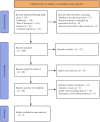
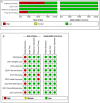

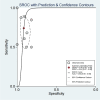
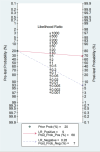
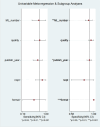



Similar articles
-
The predictive effect of different machine learning algorithms for pressure injuries in hospitalized patients: A network meta-analyses.Heliyon. 2022 Nov 2;8(11):e11361. doi: 10.1016/j.heliyon.2022.e11361. eCollection 2022 Nov. Heliyon. 2022. PMID: 36387440 Free PMC article.
-
Diagnostic accuracy of machine-learning-assisted detection for anterior cruciate ligament injury based on magnetic resonance imaging: Protocol for a systematic review and meta-analysis.Medicine (Baltimore). 2019 Dec;98(50):e18324. doi: 10.1097/MD.0000000000018324. Medicine (Baltimore). 2019. PMID: 31852123 Free PMC article.
-
Machine learning for the prediction of diabetes-related amputation: a systematic review and meta-analysis of diagnostic test accuracy.Clin Exp Med. 2025 May 10;25(1):151. doi: 10.1007/s10238-025-01697-w. Clin Exp Med. 2025. PMID: 40348887 Free PMC article. Review.
-
Radiomics diagnostic performance for predicting lymph node metastasis in esophageal cancer: a systematic review and meta-analysis.BMC Med Imaging. 2024 Jun 12;24(1):144. doi: 10.1186/s12880-024-01278-5. BMC Med Imaging. 2024. PMID: 38867143 Free PMC article.
-
A systematic review and meta-analysis of the utility of quantitative, imaging-based approaches to predict radiation-induced toxicity in lung cancer patients.Radiother Oncol. 2025 Jul;208:110935. doi: 10.1016/j.radonc.2025.110935. Epub 2025 May 11. Radiother Oncol. 2025. PMID: 40360049 Review.
Cited by
-
Efficacy and safety of immune checkpoint inhibitors combined with iodine-125 seed implantation in driver gene-negative non-small cell lung cancer: a retrospective cohort study.J Thorac Dis. 2025 Jan 24;17(1):278-288. doi: 10.21037/jtd-24-1403. Epub 2025 Jan 22. J Thorac Dis. 2025. PMID: 39975729 Free PMC article.
-
Integration of intratumoral and peritumoral CT radiomic features with machine learning algorithms for predicting induction therapy response in locally advanced non-small cell lung cancer.BMC Cancer. 2025 Mar 13;25(1):461. doi: 10.1186/s12885-025-13804-x. BMC Cancer. 2025. PMID: 40082786 Free PMC article.
-
Predictive value of machine learning for radiation pneumonitis and checkpoint inhibitor pneumonitis in lung cancer patients: a systematic review and meta-analysis.Sci Rep. 2025 Jul 1;15(1):20961. doi: 10.1038/s41598-025-05505-z. Sci Rep. 2025. PMID: 40596105 Free PMC article.
-
Predictive significance of the hemoglobin, albumin, lymphocyte, and platelet score for radiation pneumonitis in lung cancer patients: a respective comparative study with dosimetric parameters.Front Oncol. 2025 Jun 4;15:1605094. doi: 10.3389/fonc.2025.1605094. eCollection 2025. Front Oncol. 2025. PMID: 40538836 Free PMC article.
-
Balancing Innovation and Safety: Prediction, Prevention, and Management of Pneumonitis in Lung Cancer Patients Receiving Novel Anti-Cancer Agents.Cancers (Basel). 2025 Jul 30;17(15):2522. doi: 10.3390/cancers17152522. Cancers (Basel). 2025. PMID: 40805219 Free PMC article. Review.
References
-
- Wallat EM, Wuschner AE, Flakus MJ, Gerard SE, Christensen GE, Reinhardt JM, Bayouth JE. Predicting pulmonary ventilation damage after radiation therapy for nonsmall cell lung cancer using a ResNet generative adversarial network. Med Phys. 2023;50(5):3199–209. 10.1002/mp.16311. (Epub 2023 Feb 22 PMID: 36779695). - PubMed
-
- Nam JK, Kim AR, Choi SH, Kim JH, Han SC, Park S, Lee YJ, Kim J, Cho J, Lee HJ, Lee YJ. Pharmacologic Inhibition of HIF-1α Attenuates Radiation-Induced Pulmonary Fibrosis in a Preclinical Image Guided Radiation Therapy. Int J Radiat Oncol Biol Phys. 2021;109(2):553–66. 10.1016/j.ijrobp.2020.09.006. (Epub 2020 Sep 15 PMID: 32942004). - PubMed
-
- Wang JY, Chen KY, Wang JT, Chen JH, Lin JW, Wang HC, Lee LN, Yang PC. Outcome and prognostic factors for patients with non-small-cell lung cancer and severe radiation pneumonitis. Int J Radiat Oncol Biol Phys. 2002;54(3):735–41. 10.1016/s0360-3016(02)02994-2. (PMID: 12377325). - PubMed
-
- Appelt AL, Vogelius IR, Farr KP, Khalil AA, Bentzen SM. Towards individualized dose constraints: Adjusting the QUANTEC radiation pneumonitis model for clinical risk factors. Acta Oncol. 2014;53(5):605–12. 10.3109/0284186X.2013.820341. (Epub 2013 Aug 19 PMID: 23957623). - PubMed
-
- Bradley JD, Hu C, Komaki RR, Masters GA, Blumenschein GR, Schild SE, Bogart JA, Forster KM, Magliocco AM, Kavadi VS, Narayan S, Iyengar P, Robinson CG, Wynn RB, Koprowski CD, Olson MR, Meng J, Paulus R, Curran WJ Jr, Choy H. Long-Term Results of NRG Oncology RTOG 0617: Standard- Versus High-Dose Chemoradiotherapy With or Without Cetuximab for Unresectable Stage III Non-Small-Cell Lung Cancer. J Clin Oncol. 2020 Mar 1;38(7):706–714. 10.1200/JCO.19.01162. Epub 2019 Dec 16. PMID: 31841363; PMCID: PMC7048161. - PMC - PubMed
Publication types
MeSH terms
LinkOut - more resources
Full Text Sources
Medical

